| Jenny Holzer
The Art History Archive - Biography & Art
Biography: An American Neo-Conceptualist artist, Jenny Holzer (born 1950) utilized the homogeneous rhetoric of modern information systems in order to address the politics of discourse. In 1989 she became the first female artist chosen to represent the United States at Italy's Venice Biennale. Jenny Holzer was born July 29, 1950, in Gallipolis, Ohio, into a family of two generations of Ford auto dealers. She completed her undergraduate degree at Ohio University in Athens after attending Duke University and the University of Chicago. While enrolled in the Rhode Island School of Design, Holzer experimented with an abstract painting style influenced by the color field painters Mark Rothko and Morris Louis. In 1976 she moved to Manhattan, participating in the Whitney Museum's independent study program. Language as Art Holzer's conception of language as art, in which semantics developed into her aesthetic, began to emerge in New York. The Whitney program included an extensive reading list incorporating Western and Eastern literature and philosophy. Holzer felt the writings could be simplified to phrases everyone could understand. She called these summaries her "Truisms" (1978), which she printed anonymously in black italic script on white paper and wheat-pasted to building facades, signs, and telephone booths in lower Manhattan. Arranged in alphabetical order and comprised of short sentences, her "Truisms" inspired pedestrians to scribble messages on the posters and make verbal comments. Holzer would stand and listen to the dialogues invoked by her words.
Holzer initiated the "Living Series" in 1981, which she printed on aluminum and bronze plaques, the presentation format used by medical and government buildings. "Living" addressed the necessities of daily life: eating, breathing, sleeping, and human relationships. Her bland, short instructions were accompanied with paintings by the American artist Peter Nadin, whose portraits of men and women attached to metal posts further articulated the emptiness of both life and message in the information age. Art and Technology
Her attempt to make sense out of contemporary life within a technological framework also suggests the limitations of the information age, in which the world of advertising consumes everything, yet an underlying message no longer exists. After the "Survival Series," Holzer's installations became more monumental in scale and more quasi-religious. Her "Under a Rock" exhibition combined the modern media of the communications industry, the electronic signboard, with marble benches printed in the block letters used in national cemeteries. The language measured angst and violence with the apathetic reportage of the most seasoned news personae: CRACK THE PELVIS SO SHE LIES RIGHT, THIS IS A MISTAKE. WHEN SHE DIES YOU CANNOT REPEAT THE ACT, etc. The vivid juxtaposition between horrifying subject matter and the authoritarian voice, coupled with flashing diodes and cold marble, jars the spectator with its apparent paradox and brutal insistency. By utilizing the pronoun "she," Holzer allied the victimization with the female. The new urgency of the "voice" in Holzer's "Under a Rock" installation, first exhibited in 1986 at the Barbara Gladstone Gallery in New York, revealed a Holzer more overtly building images that suggest male power and control over women.
Virtual Art The multimedia extravaganzas of Holzer's later installations, such as the 1989 Guggenheim exhibition, are exemplified by a 535-foot running electronic signboard spiraled around the core of Frank Lloyd Wright's architecture, flashing garish lights on the monumental stone benches arranged in a large circle on the floor below. In 1989 also, she became the first female artist chosen to represent the United States at the Venice Biennale, the international art world's premiere event. For the Biennale, Holzer designed posters, hats, and t-shirts to be sold in the streets of Venice, while her L.E.D. signboards and marble benches occupied the solemn and austere exhibition space. Her words were translated into multiple languages in order to communicate to an international audience. Despite the fact that she had won the prestigious Golden Lion award at the Biennale, Holzer also started to draw more negative reactions to her work. The size and expense of her exhibits, as well as her growing popularity in the art world, led some to accuse her of becoming elitist. Holzer withdrew from the art world for a few years and then returned in 1993 with a fresh approach to her work and a new emphasis on the immaterial. In October of 1993 she partook in a virtual reality exhibit at the Guggenheim Museum. The following year she produced her next series, "Lustmord," which opened at the Barbara Gladstone Gallery in New York. The title is taken from a German word that means murder plus sexual pleasure. She was inspired by the violence of the war in Bosnia, formerly a republic of Yugoslavia. In 1996 she participated in the First Biennale of Florence. By accepting multivalent formats for her media-conscious verbal imagery, Holzer created a populist art of expressive and poetic force.
|
|
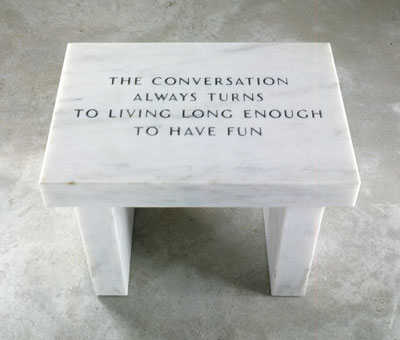 TRUISMS (1979-1983)
TRUISMS (1979-1983)
LUSTMORD: Lusmord is the German word for sexual murder involving rape. With LUSTMORD, Jenny Holzer peels back those layers of insulation and invites viewers into the dark corners of the human psyche. It has become appartent that sex murder is an evil so persistent in western culture that it has been "tolerated" to a suprising degree. We want to belive that only the deeply insane, someone reduced to animalistic violence, could twist love and hate in such a sadistic manner, but humans have created these heinous crimes for centuries. After hearing about the Bosnian war crimes Jenny Holzer was inspired to create LUSTMORD. LUSTMORD has been building ever since TRUISMS "Murder has its sexual side" Through the years, the anonymous tone voice of authority has evolded into a more pseronal and despairing voice The ideas of sex, war and death have continued, but now they take a personal tone as you hear the victim and the child of the victim's view. Lusmord is composed of 4 LED, text billboard, signs. It also has tables or bones, certain bones that are connected with sensuality. For example, fingertips and collar bones. Certain bones have metal bands around them saying parts of the poem: HER BREASTS for example. The led signs interchange the perpetrator, the victim and the observer's text. When reading the billboard text compiled you perceive the encounter as a sexual tryst at first. Talks about breasts and hair and some tenderness. Then, when getting into the subject you realize pain was invovled, immense pain along with someone watching in anguish. The exhibit was built like a tomb, lights only from the billboard signs. You are allowed to touch the bones, the symbols of a lost woman and her lost sensuality. This exhibit although graphic is meant to expose a dark pysche and the sides of a rape/murder, a LUSTMORD. The graphicness is a tool to make the viewer realize their own mortality and the innocence of people involved in a war crime. PERPETRATOR
I SWIN IN HER AS SHE QUITES. I SINK ON HER. I SING HER A SONG ABOUT US. I STEP ON HER HANDS. I SPLAY HER FINGERS. SHE ROOTS WITH HER BLUNT FACE. SHE HUNTS ME WITH HER MOUTH. SHE HAS THREE COLORS IN HER EYES. I BITE HER CLOSED AGAIN. I AM NEAR HER MILK. I TELL HER TO SOAP HERSELF. SHE TIGHTENS AND I HIT HER. I WASH HER OUT. I WATCH HER WHILE SHE THINKS ABOUT ME. HER SALIVA RUNS WHEN SHE SLEEPS. I HOOK HER SPINE. SHE HAS A URINE SMELL. HER SWALLOW REFLEX IS GONE. HER HEAD EXPLODES IN THE FIRE. HER BREASTS ARE ALL NIPPLE. SHE ACTS LIKE AN ANIMAL LEFT FOR COOKING. I FIND HER SQUATTING ON HER HEELS AND THIS OPENS HER SO I CAN GET HER FROM BELOW. I TAKE HER FACE WITH ITS FINE HAIRS. I POSITION HER MOUTH. I WANT TO FUCK HER WHERE SHE HAS TOO MUCH HAIR. I HOOK MY CHIN OVER HER SHOULDER. NOW THAT SHE CAN STILL CONCENTRATE. SHE HAS NO TASTE LEFT TO HER AND THIS MAKES IT EASIER FOR ME. THE COLOR OF HER WHERE SHE IS INSIDE IS ENOUGH TO MAKE ME KILL HER. VICTIM
I AM AWAKE IN A PLACE WHERE WOMEN DIE. THE BIRD TURNS ITS HEAD AND LOOKS AT ME WITH ONE EYE AS YOU ENTER. MY BREASTS ARE SO SWOLLEN THAT I BITE THEM YOUR AWFUL LANGUAGE IS IN THE AIR BY MY HEAD I DO NOT LIKE TO WALK BECAUSE I FEEL IT BETWEEN MY LEGS HAIR IS STUCK INSIDE ME MY NOSE BROKE IN THE GRASS. MY EYES ARE SORE MOVING AGAINST YOUR PALM. I HAVE THE BLOOD JELLY. WITH YOU INSDE ME COMES THE KNOWLEDGE OF MY DEATH. YOU HAVE SKIN IN YOUR MOUTH. YOU LICK ME STUPIDLY. YOU CONFUSE ME WITH SOMETHING THAY IS IN YOU. I WILL NOT PREDICT HOW YOU WANT TO USE ME. I FEEL WHO YOU ARE AND IT DOES ME NO GOOD AT ALL. I TRY TO EXCITE MYSELF SO I STAY CRAZY. WHAT IS LEFT ON THE BLANKET IS CLEAR AND THE COLOR OF HELL. OBSERVER
I WANT TO LIE DOWN BESIDE HER. I HAVE NOT SINCE I WAS A CHILD. I WILL BE COVERED BY WHAT HAS COME FROM HER. SHE BEINGS TO MAKE MISTAKES IN HER LANGUAGE AND I CORRECT HER THE WAY SHE HAS TAUGHT ME. I FIND HER TOWERLS SHOVED IN TIGHT SPOTS. I TAKE THEM TO BURN ALTHOUGH I FEAR TOUCHING THINGS. SHE ASKS ME TO SLEEP IN THE HOUSE BUT I WILL NOT WITH HER NEW BODY AND ITS NOISES AND WETNESS. SHE SMILES AT ME BECAUSE SHE IMAGINES I CAN HELP HER. SHE COUGHS THE MOUTH STRINGS. I WANT TO BRUSH HER HAIR BUT THE SMELL OF HER MAKES ME CROSS THE ROOM. I HELD MY BREATH AS LONG AS I COULD. I KNOW I DISAPPOINT HER. SHE STARTED RUNNING WHEN EVERYTHING BEGAN POURING FROM HER BECAUSE SHE DID NOT WANT TO BE SEEN. SHE FELL ON THE FLOOR IN MY ROOM. SHE TRIED TO BE CLEAN BUT SHE WAS NOT. I SEE HER TRAIL. HER GORE IS IN THE BALL OF CLEANING RAGS. I CARRY OUT THE DAMPNESS FROM MY MOTHER. I RETURN TO HIDE HER JEWELRY THE BLACK SPECKS INSIDE MY EYES FLOAT ON HER BODY. I WATCH THEM WHILE I THINK ABOUT HER. I WANT TO SUCK ON HER TO MAKE HER RESPOND. I WALK OUTSIDE TO THE PATH AND SEE THE PLANTS, EACH HANDLED BY HER, UNMARKED BY HER DYING. SHE IS NARROW AND FLAT IN THE BLUE SACK AND I STAND WHEN THEY LIFT HER. | |
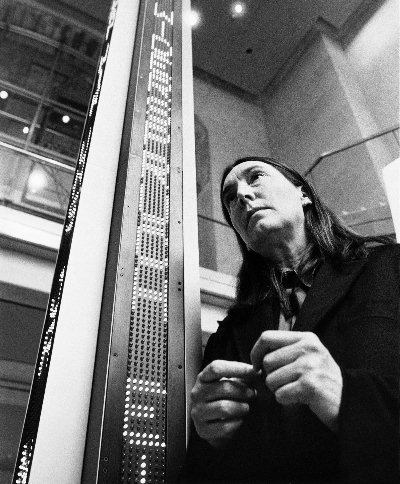
 The participatory effect and the underground format were vital components of Holzer's "Truisms" and of her second series, the "Inflammatory Essays," which laconically articulated Holzer's concerns and anxieties about contemporary society. Holzer printed the "Essays" in alphabetical order, first on small posters and then as a manuscript entitled The Black Book (1979). Until the late 1980s, Holzer refused to produce them in any non-underground formats because of their militant nature. Her declarative language assumed particular force and violence in the multiple viewpoints of the "Essays," ranging from extreme leftist to rightist.
The participatory effect and the underground format were vital components of Holzer's "Truisms" and of her second series, the "Inflammatory Essays," which laconically articulated Holzer's concerns and anxieties about contemporary society. Holzer printed the "Essays" in alphabetical order, first on small posters and then as a manuscript entitled The Black Book (1979). Until the late 1980s, Holzer refused to produce them in any non-underground formats because of their militant nature. Her declarative language assumed particular force and violence in the multiple viewpoints of the "Essays," ranging from extreme leftist to rightist.
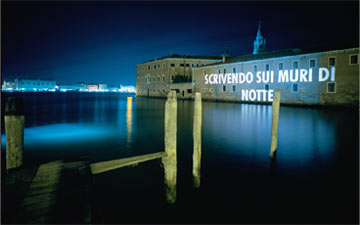 The medium of modern computer systems became an important component in Holzer's work in 1982, when nine of her "Truisms" flashed at forty-second intervals on the giant Spectacolor electronic signboard in Times Square. Sponsored by the Public Arts Fund program, the use of the L.E.D. (light emitting diode) machine allowed Holzer to reach a larger audience. By combining a knowledge of semantics with modern advertising technologies, Holzer established herself as a descendant of the conceptualist and
The medium of modern computer systems became an important component in Holzer's work in 1982, when nine of her "Truisms" flashed at forty-second intervals on the giant Spectacolor electronic signboard in Times Square. Sponsored by the Public Arts Fund program, the use of the L.E.D. (light emitting diode) machine allowed Holzer to reach a larger audience. By combining a knowledge of semantics with modern advertising technologies, Holzer established herself as a descendant of the conceptualist and 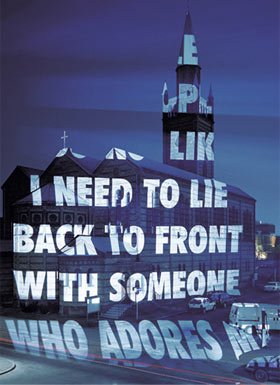 The birth of her first child in 1989 inspired Holzer's "Laments," perhaps the most personal and angst-ridden series she had done. The "Laments" address motherhood, violation, pain, torture, and death in the voices of "thirteen assorted dead people" (J. Holzer). The personae range in sex and age, yet a common insistency permeates their disembodied words. One passage suggests infanticide: IF THE PROCESS STARTS I WILL KILL THIS BABY A GOOD WAY. The contradictions inherent to the rhetoric, "to kill" but in "a good way," shape the negations and arbitrariness of contemporary linguistics. Holzer accessed the language structure and media of contemporary politics and advertising in order to reveal the tensions and male domination apparent in the contemporary linguistic system.
The birth of her first child in 1989 inspired Holzer's "Laments," perhaps the most personal and angst-ridden series she had done. The "Laments" address motherhood, violation, pain, torture, and death in the voices of "thirteen assorted dead people" (J. Holzer). The personae range in sex and age, yet a common insistency permeates their disembodied words. One passage suggests infanticide: IF THE PROCESS STARTS I WILL KILL THIS BABY A GOOD WAY. The contradictions inherent to the rhetoric, "to kill" but in "a good way," shape the negations and arbitrariness of contemporary linguistics. Holzer accessed the language structure and media of contemporary politics and advertising in order to reveal the tensions and male domination apparent in the contemporary linguistic system.
 Examples of Jenny Holzer's Art:
Examples of Jenny Holzer's Art:

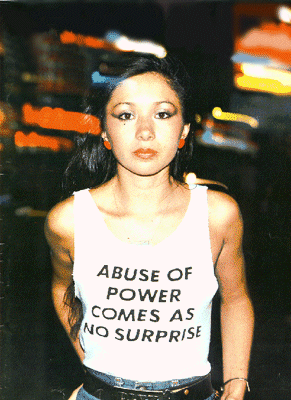
 SURVIVAL SERIES (1983-1985)
SURVIVAL SERIES (1983-1985)